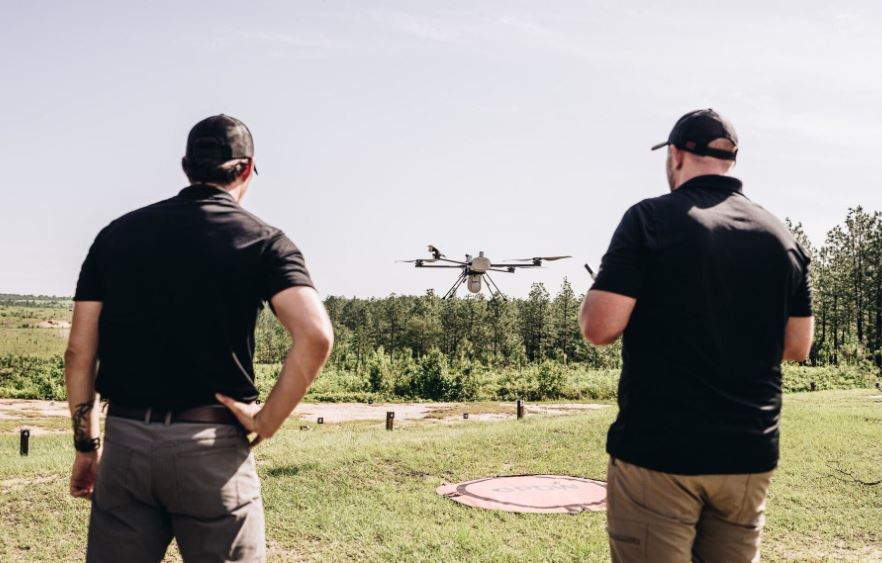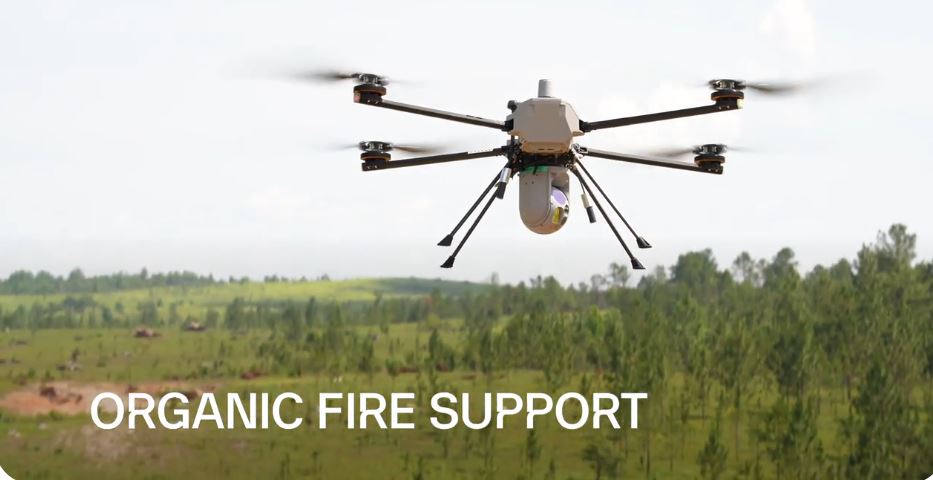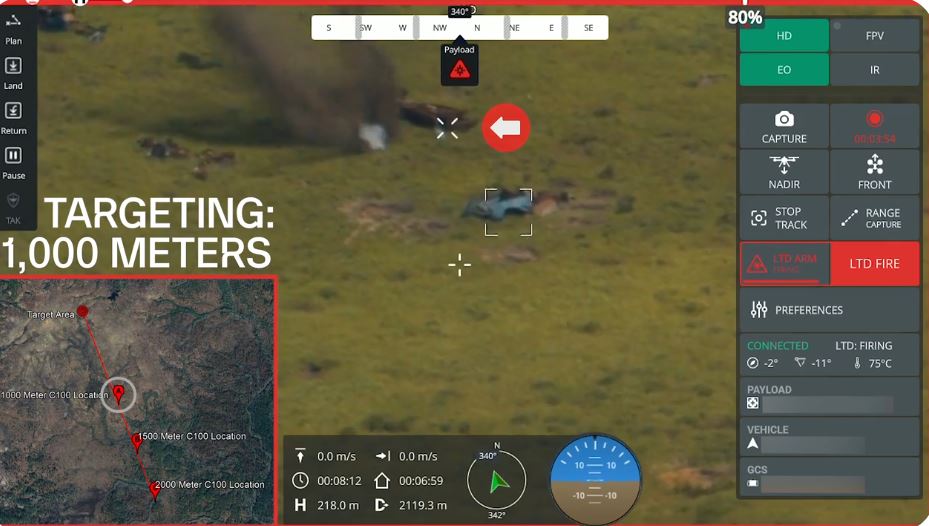In a demonstration of the next-generation joint air warfare concept, Performance Drone Works (PDW), a US company specializing in artificial intelligence and unmanned aerial systems (UAS), and the US Department of Defense, exhibited joint fire support using the PDW C100 and F-35A Lightning II multirole stealth fighter jet.
The demonstration involved the fifth-generation stealth fighter jet working in tandem with a UAS to conduct precision air strikes on targets.
The test, carried out in July, involved the PDW C100 drones illuminating ground targets with laser designators before the F-35A Lightning II fighter jets released and guided four inert GBU-12 Paveway II bombs in precision air strikes.
According to a statement released by the company, “Equipped with the Leonardo STAG5 Laser Target Designator (LTD), the C100 successfully guided four inert GBU-12 precision munitions released from F-35 to predetermined targets.”
This exercise demonstrated the ability of an operator to safely mark targets from a standoff range with the C100 for joint fires capabilities without the need for supporting aircraft, the statement added.
This is a slightly different warfighting concept than the Loyal Wingmen Drones.
Loyal Wingman drones are advanced, semi-autonomous unmanned aerial vehicles (UAVs) designed to operate alongside manned fighter jets, enhancing their capabilities in combat missions. These drones, like Boeing’s Airpower Teaming System or Kratos’ XQ-58 Valkyrie, act as force multipliers, performing tasks such as reconnaissance, electronic warfare, missile strikes, or decoy operations.

However, Loyal Wingman drones are operated by the manned aircraft, whereas a ground-based remote pilot operates the C100.
Though the concept also overlaps in several ways. For instance, in both scenarios, the UAVs communicate with the manned fighter jets, acting as a force multiplier for the manned aircraft, enabling coordinated tactics while reducing risk to human pilots.
Further, both concepts aim to create a networked, cost-effective air combat system, blending manned and unmanned platforms.
Organic Cross-Domain Fire Capability
The demonstration featured three separate engagements at ranges of 1000, 1500, and 2000 meters from the C100 to the target. The C100 loitered for approximately 35 minutes at a distance of 3 km from the operator and captured a detailed visual description, enabling rapid target acquisition.
Designed as an organic fires platform, the C100 extends soldiers’ effectiveness with a versatile payload suite supporting ISR, target designation, and kinetic effects.
“This is the second in a series of demonstrations aimed to prove the C100 as the ultimate organic fires platform,” said PDW CEO and co-founder Ryan Gury.
“The C100 offers a huge leap in tactical flexibility for the warfighter and PDW is ready to equip our forces with a system that can provide that support across various domains,” Gury added.
“This demonstration validated the C100’s role as a modular strike enabler, integrating LTD capability for rapid target handoff to indirect fire, close air support, and maritime platforms.”
“As a stand-off targeting solution, the system delivers organic precision lasing from extended ranges, reducing exposure to manned elements while enhancing operational reach,” PDW said in its statement.
The video released by the company, along with the statement, shows a ground-based operator flying a C100 UAV, which illuminates a target with the help of Leonardo STAG5 Laser Target Designator (LTD). A F-35A Lightning II fighter jet is then shown flying overhead the C100 drone and releasing the GBU-12 precision munitions.
The statement by PDW indicated that all munitions hit their intended targets.
Also, the C100 was able to loiter for nearly 35 minutes before illuminating its target. The GBU-12 bombs used in the trial are derived from the Paveway II kit, which converts a 500-pound Mk 82 bomb into a laser-guided munition, with a range exceeding 14 kilometers.

However, it must be noted that the US Air Force (USAF) has so far not commented publicly on the demonstration.
This joint air warfare concept will allow the operators to identify targets from a safe distance, eliminating the need for F-35 fighter jets to fly at low altitudes for target acquisition or for some other aircraft to perform that mission, thereby significantly reducing the risk to expensive manned fighter jets as well as the human pilots.
The use of expendable, tactical drones in conjunction with stealth fighter jets represents the evolution of a new air warfare doctrine where the stealth fighter jet can release munitions from standoff ranges, while the more risky role of ISR, electronic warfare, and target acquisition is relegated to low-cost drones.
It represents a new air combat doctrine marked by integrated warfare and interaction between various technological layers to combine stealth with operational flexibility.
However, this was not the first demonstration of such capability by the USAF.
Earlier in June 2024, during the U.S.-Philippine bilateral exercise, the F-35Bs released GBU-32 JDAMs on floating targets identified by Philippine drones and a C-130.
C100 Heavy-Lift Quadcopter
The C100 is a man-packable heavy-lift quadcopter platform that features world-leading flight endurance, capable of missions of up to 74 minutes with a payload. The low-SWaP (size, weight, and power) drone easily folds down into a small rucksack and can be deployed and airborne in under two minutes.
According to Unmanned Systems Technology, the versatile system carries up to 21.4 lbs and features universal third-party payload connectivity with support for a wide variety of protocols. Standard payload options include Trillium’s military-grade EO/IR gimbals.

The aircraft also features an independent fixed flight camera for first-person view, enhancing operator navigation. Advanced autonomy capabilities include object detection, visual inertial odometry for GNSS-denied environments, and vision-based collision prevention.
It can operate in environments with temperatures ranging from -20 to 57 degrees Celsius (-4 to 135 degrees Fahrenheit) and resist dust particles and water.
C100 has a range of 6 miles (10 kilometers), a speed of 40 miles (65 kilometers) per hour, a maximum altitude of 12,000 feet (3,658 meters), and 74 minutes of endurance.
In December last year, Performance Drone Works (PDW) received more than US$15.3 million in contracts to deliver the C100 small unmanned aerial systems (sUAS) to the US Army.
“The C100 drone is setting a new standard for battlefield agility and operational impact, equipping Soldiers with the ability to conduct missions autonomously without external fire support,” PDW Co-Founder and CEO Ruan Gury had said at that time.
Earlier in September 2024, PDW was selected for the US Army’s Directed Requirement for Company-Level sUAS, a broader program seeking small drones for company-level intelligence, surveillance, target acquisition, and reconnaissance missions.
The integration between the C100 and the F-35A further enhances the drone’s operational strengths. This integration represents a next-generation air combat doctrine where target illumination and munition guidance are no longer dependent on manned aircraft and could be performed by low-cost, expendable drones.
- Sumit Ahlawat has over a decade of experience in news media. He has worked with Press Trust of India, Times Now, Zee News, Economic Times, and Microsoft News. He holds a Master’s Degree in International Media and Modern History from the University of Sheffield, UK.
- VIEWS PERSONAL OF THE AUTHOR.
- He can be reached at ahlawat.sumit85 (at) gmail.com




